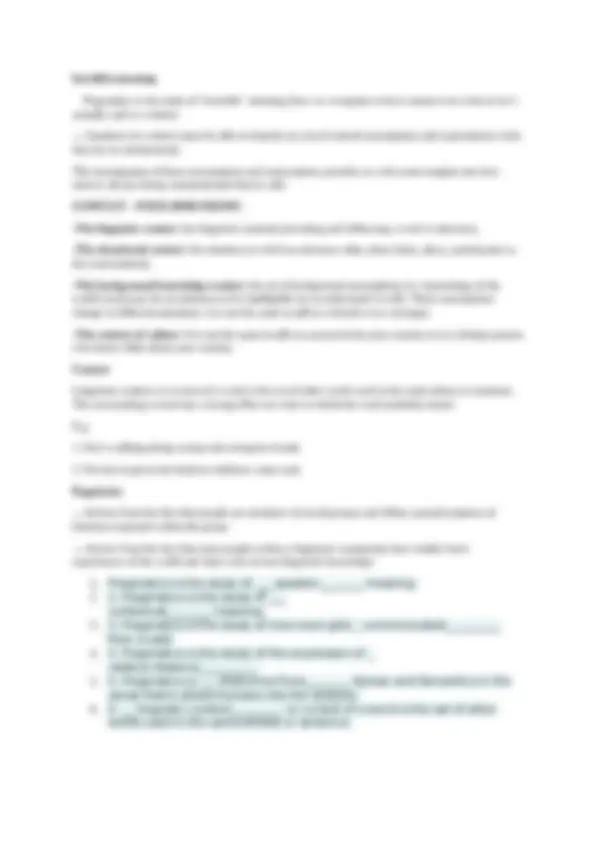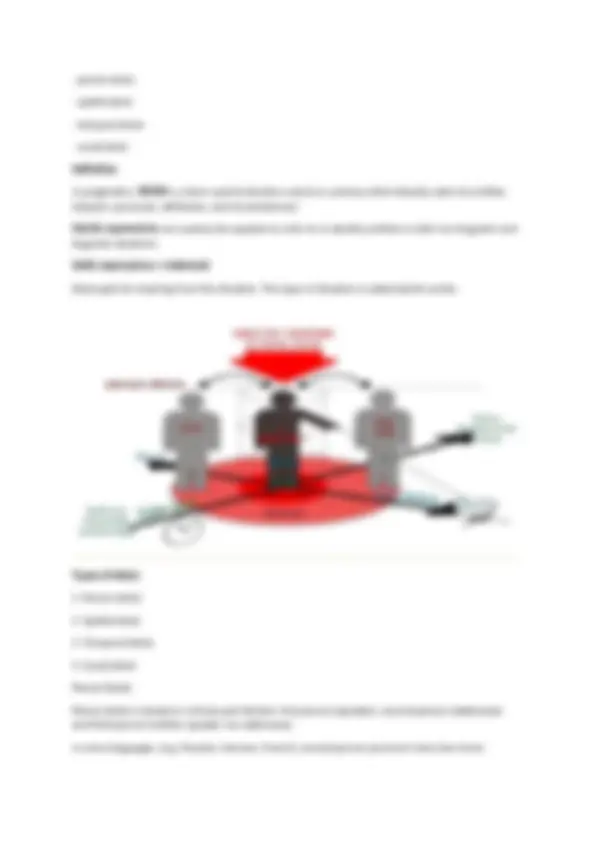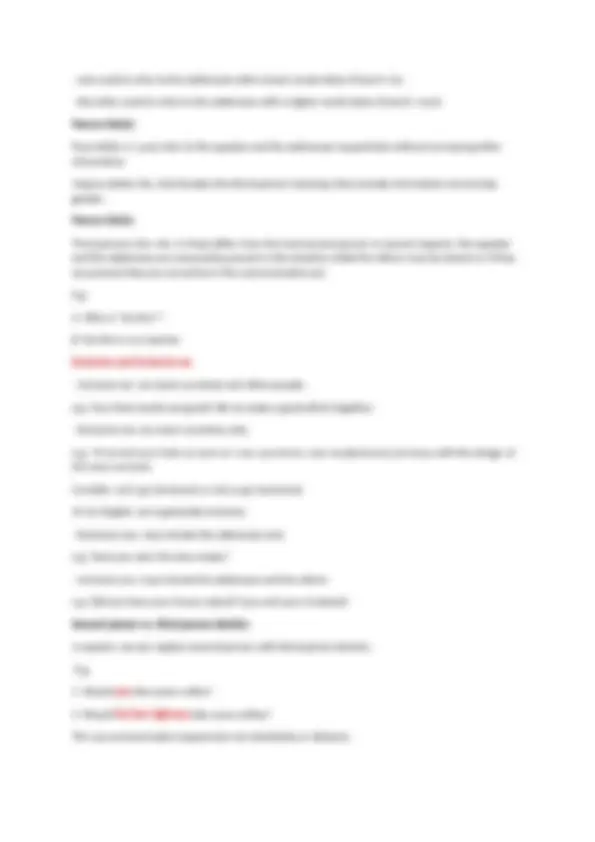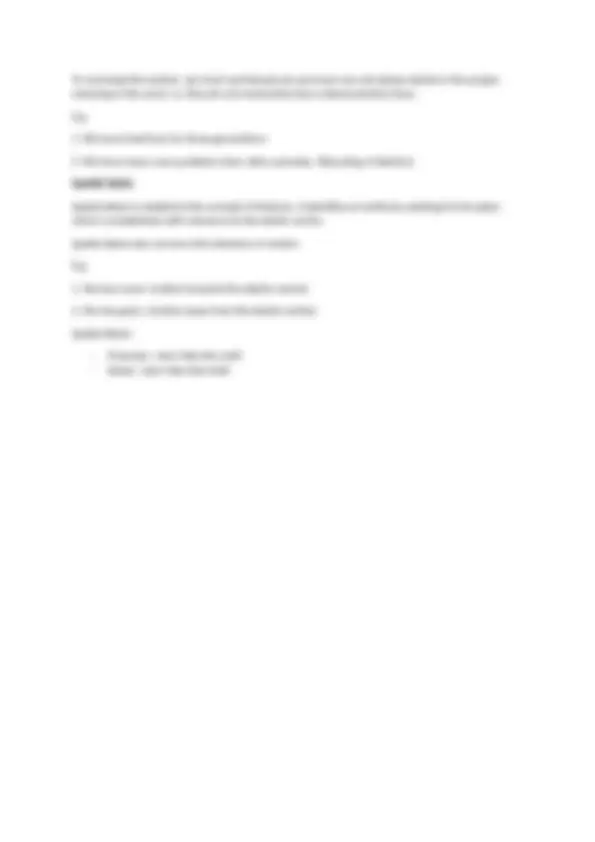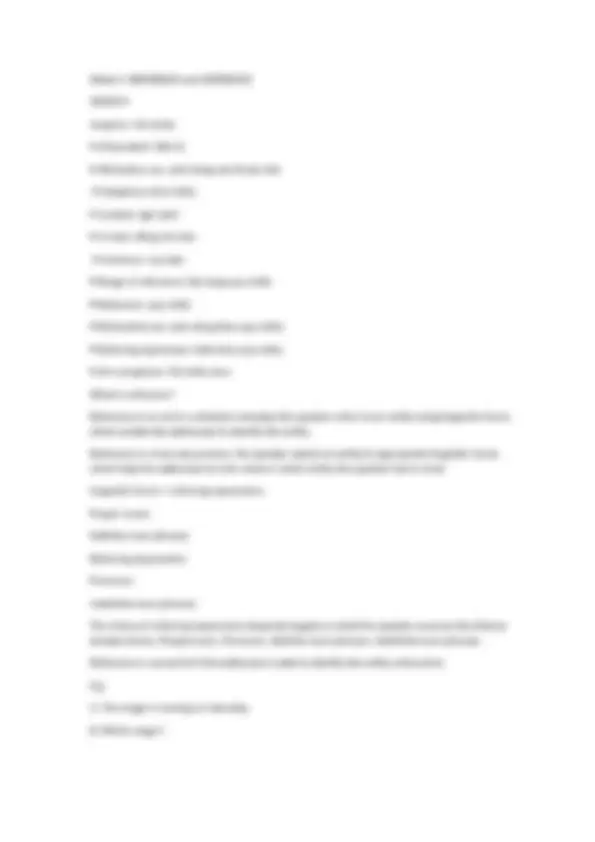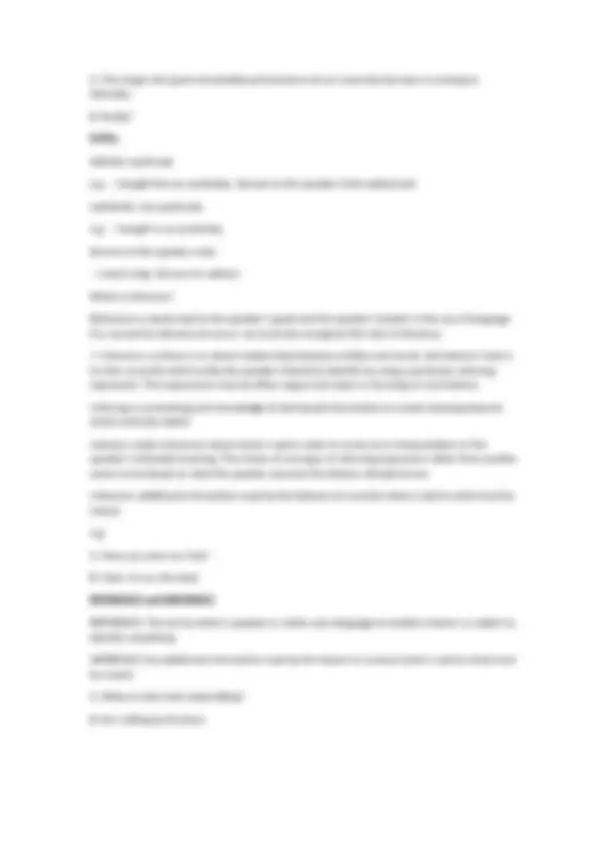Download Pragmatics: An Introduction to the Study of Speaker Meaning and Context and more Summaries English Language in PDF only on Docsity!
Course outline Week1. Introduction Week 2. Deixis & Distance Week 3. Reference & Inference Week 4. Presupposition & Entailment Week 5. Cooperation & Implicature Week 6. Speech acts Week 7. Politeness & Interaction Week 8. Conversation and preference structure Week 9. Culture and Discourse Week 10. Revision
Week 1. Introduction What is Pragmatics? Definition and Background There are four areas: → Pragmatics is the study of speaker meaning. → Pragmatics is the study of contextual meaning. → Pragmatics is the study of how more gets communicated than it is said. → Pragmatics is the study of the expression of relative distance. Definition and Background
- Pragmatics is the study of speaker meaning: concerned with the study of meaning as communicated by a speaker(or writer) and interpreted by a listener (or reader) → the analysis of what people mean by their utterances rather than what the words or phrases in those utterances might mean by themselves.
- Pragmatics is the study of contextual meaning: involves the interpretation of what people mean in a particular context and how the context influences what is said → requires a consideration of how speakers organize what they want to say in accordance with who they are talking to, where, when, and under what circumstances
- Pragmatics is the study of how more gets communicated than it is said: explores how listeners can make inferences about what is said in order to arrive at an interpretation of the speaker’s intended meaning → explores how a great deal of what is unsaid is recognized as part of what is communicated (or the investigation of invisible meaning)
- Pragmatics is the study of the expression of relative distance: what determines the choice between the said and the unsaid? → the notion of distance On the assumption of how close or distant (physical, social, or conceptual → shared experience) the listener is, speakers determine how much needs to be said
Invisible meaning Pragmatics is the study of ‘invisible’ meaning (how we recognize what is meant even when it isn’t actually said or written) → Speakers (or writers) must be able to depend on a lot of shared assumptions and expectations when they try to communicate. The investigation of those assumptions and expectations provides us with some insights into how more is always being communicated than is said. CONTEXT - FOUR DIMENSIONS -The linguistic context : the linguistic material preceding and following a word or utterance; -The situational context : the situation in which an utterance takes place (time, place, participants in the conversation); -The background knowledge context : the set of background assumptions (i.e. knowledge of the world) necessary for an utterance to be intelligible (or to understand it well). These assumptions change in different situations: it is not the same to talk to a friend or to a stranger; -The context of culture : It is not the same to talk to a person from your country or to a foreign person who knows little about your country. Context Linguistic context, or co-text of a word is the set of other words used in the same phrase or sentence. The surrounding co-text has a strong effect on what we think the word probably means. E.g.
- She’s walking along a steep and overgrown bank.
- She has to get to the bank to withdraw some cash Regularity → derives from the fact that people are members of social groups and follow general patterns of behavior expected within the group → derives from the fact that most people within a linguistic community have similar basic experiences of the world and share a lot of non-linguistic knowledge
- Pragmatics is the study of ___ speaker________ meaning.
- Pragmatics is the study of ___ contextual________ meaning.
- Pragmatics is the study of how more gets _ communicated__________ than is said.
- Pragmatics is the study of the expression of _ relative distance__________.
- Pragmatics is ___ distinctive from________ Syntax and Semantics in the sense that it allows humans into the analysis.
- __ linguistic context_________, or co-text of a word is the set of other words used in the same phrase or sentence.
- What derives from the fact that people are members of social groups and follow general patterns of behavior expected within the group is called ____ regularity_______.
- Most people within a _ linguistic community__________ have similar basic experience of the world and share a lot of non-linguistic knowledge.
- What is included in the study of pragmatics? speech act 10.What is not included in the study of pragmatics? word meaning 11.Language is a tool of human (11) interaction Via language the speaker conveys his or her intended (12) information to the addressee who receives it and (13) responds to it by providing the requested information and asking the (14)speaker , now the addressee, for the information he or she is (15) interested in. (16) Communication , then, is a two-way interaction: it involves the speaker and the addressee. This holds good for both (17) dialogues and monologues, the only difference is that the addressee in a dialogue turns into the speaker while in the (18) dialogues the addressee is the reader or the (19) listener, only: this type of addressee (20) dialogues turns into the speaker.
Week 2. Deixis and Distance TERMS: Dexis: chỉ xuất Deitic expression: biểu thức chỉ xuất Indexicals: chỉ tố Attributive use: cách dùng nêu thuộc tính Context: ngữ cảnh Co-text: đồng văn bản Deictic center: tâm chỉ xuất (mốc chỉ xuất) Deictic projection: xạ ảnh chỉ xuất Person deixis: chỉ xuất nhân xưng Spatial deixis: chỉ xuất không gian Temporal deixis: chỉ xuất thời gian Social deixis: chỉ xuất xã hội Deixis and Distance
- Definition
- Types of deixis:
- person dexis
- spatial dexis
- temporal dexis
- social dexis Definition In pragmatics, DEIXIS is a term used to denote a word or a phrase which directly refers to entities (objects, processes, attributes, and circumstances). Deictic expressions are used by the speaker to refer to or identify entities in both non-linguistic and linguistic situations. Deitic expressions = Indexicals Deixis gets its meaning from the situation. This type of situation is called deictic center. Types of deixis
- Person deixis
- Spatial deixis
- Temporal deixis
- Social deixis Person Deixis Person deixis is based on a three-part division: first person (speaker), second person (addressee), and third person (neither speaker nor addressee) In some languages, (e.g. Russian, German, French), second person pronouns have two forms:
To conclude this section, we must say that person pronouns are not always deictic in the proper meaning of the word, i.e. they do not necessarily have a demonstrative force. E.g.
- We have lived here for three generations.
- We have many more problems than other primates. (Recycling of deictics) Spatial Deixis Spatial deixis is related to the concept of distance. It identifies an entity by relating it to its place which is established with reference to the deictic centre. Spatial deixis also concerns the direction of motion. E.g.
- She has come. (motion towards the deictic centre)
- She has gone. (motion away from the deictic centre) Spatial Deixis
- Proximal: I don’t like this stuff.
- Distal: I don’t like that stuff.
To identify an entity with respect to its place in the nonlinguistic situation, the speaker can use corresponding deictic words:
- deictic adverbs here and there
- demonstrative pronouns this/that– these/those. In older texts, we can find a much larger set of deictic expressions: hither (in this direction) yonder (over there; distant from the speaker) thither (in that direction) hence (from this place) thence (from that place) Spatial Deixis: Pure deitics used independently, i.e. not followed by words naming entities Impure deitics followed by words naming the entities e.g. What is this thing? Who is this man? DEICTIC PROJECTION : when speakers act as if they are somewhere else. i.e: “I´m not here now .” (telephone answering machine) Recording is a performance for a future audience in which I project my presence to be in the required location. Temporal Deixis Temporal deixis identifies entities and processes with respect to the temporal deictic centre, which is the speaker’s time of utterance. E.g.
- the present government
- the coming winter Processes are also identified in this way:
- present processes,
- future processes. If grammaticalized, present, past and future processes have appropriate forms: present, past and future tense forms. In English, however, we have only two tenses: present and past. The present tense is temporally proximal; The past tense is temporally distant.
- What is meant by pure and impure deictics?
- Deixis is said to be related to distance. Explicate it.
- Tense is a deictic category. Could you comment on it
Spatial deixis
As a linguistic process, deixis is pointing via language. Deictic expressions, or deictics , can only be interpreted in the situation, for example, this and John/mother, father. When the child says “ Give me this ”, we may not know what this stands for. To know it, we must be in the same environment as the child. Deictics fall into two groups: 1) non-textual ( I, you, we; this, that; these, those );
- textual ( he, she, it, they ). Some non-textual deictics, e.g. this/that; these/those , can also be used in the text. Textual deictics can be used as non-textual deictics (e.g. Who is she?). In philosophical logic, the two types of deictic expressions are called indexicals. Languages show a two-way referential distinction in their deictic system: proximal (close to the speaker) and distal (far from the speaker). In other languages (e.g. Korean, Japanese), the distinction is three-way : proximal (close to the speaker1), medial (close to the addressee) and distal (far from both).
Week 3. REFERENCE and INFERENCE TERMS Anaphor: hồi chiếu Antecedent: tiền từ Attributive use: cách dùng nêu thuộc tính Cataphora: khứ chiếu Context: ngữ cảnh Co-text: đồng văn bản Inference: suy luận Range of reference: lớp hạng quy chiếu Reference: quy chiếu Referential use: cách dùng theo quy chiếu Referring expression: biểu thức quy chiếu Zero anaphora: hồi chiếu zero What is reference? Reference is an act in a situation whereby the speaker refers to an entity using linguistic forms which enable the addressee to identify the entity. Reference is a two-way process: the speaker selects an entity & appropriate linguistic forms which help the addressee to infer what or which entity the speaker had in mind. Linguistic forms = referring expressions Proper nouns Definite noun phrases Referring expressions Pronouns Indefinite noun phrases The choice of referring expressions depends largely on what the speaker assumes the listener already knows: Propernouns, Pronouns, Definite noun phrases, Indefinite noun phrases. Reference is successful if the addressee is able to identify the entity referred to. E.g. A: The singer is coming on Saturday. B: Which singer?
REFERENCE AND INFERENCE
REFERENTIAL and ATTRIBUTIVE USE Referential use: has one specific entity in mind. e.g. There’s a man waiting for you. Attributive use: entity only known in terms of descriptive properties (meaning 'who/whatever fits the description’) e.g. He wants to marry a woman with lots of money NAMES and REFERENTS Pragmatic connection between proper names and objects is conventionally associated within a socio-culturally defined community. Convention between all members of a cultural/language community: collaboration of the intention to identify and the recognition of intention. 'Shakespeare' does not refer only to a specific person: - Can I borrow your Shakespeare? -Yeah, it's over there on the table. Conventional set of entities: (e.g. things the writer produced)
- Shakespeare takes up the whole bottom shelf. -We're going to see Shakespeare in London.
- I hated Shakespeare at school. 'the cheese sandwich' can refer to a person: -Where's the cheese sandwich sitting?
- He's over there by the window The role of co-text e.g. 1. Brazil wins World Cup.
- Japan wins first round of trade talks. The ability to identify intended referents does not just depend on the understanding of the referring expression, but is aided by the linguistic material, or co-text, accompanying it. It should be noted that entities expressed by proper nouns may not be identified successfully since they may have more than one possible referent. Referring expressions may have a range of reference. e.g.
- The cheese sandwich is made with white bread.
- The cheese sandwich left without paying. Co-text: limits the range of possible interpretations. CO-TEXT and CONTEXT
CO-TEXT
linguistic part of the environment in which a referring expression is used CONTEXT physical environment and (speech) conventions. e.g. The heart-attack mustn't be moved. (hospital)
A. an act in which a speaker, or writer, uses linguistic forms to enable a
listener, or reader, to identify something
B. linguistic forms used to enable the addressee to identify the entity
C. whoever/whatever fits the description attribute use
D. when the speaker has a person in mind
E. a number of possible referents
F. linguistic part of the environment in which a referring expression is used.
G. the physical environment context
H. the use of an expression that depends specifically upon an antecedent
expression
I. the use of an expression or word that co-refers with a later, more specific,
expression in the discourse.
J. initial referring expression antecedent


